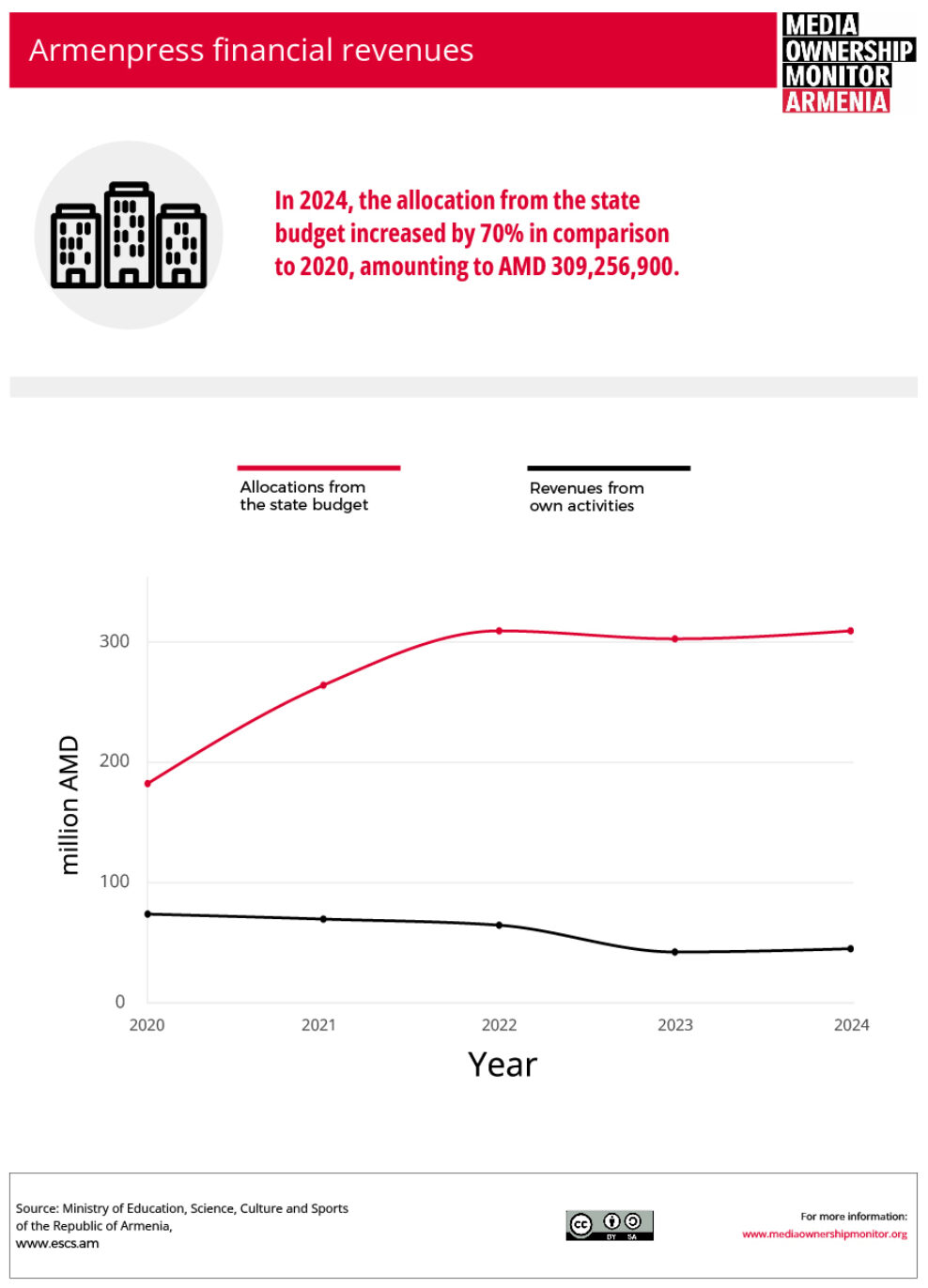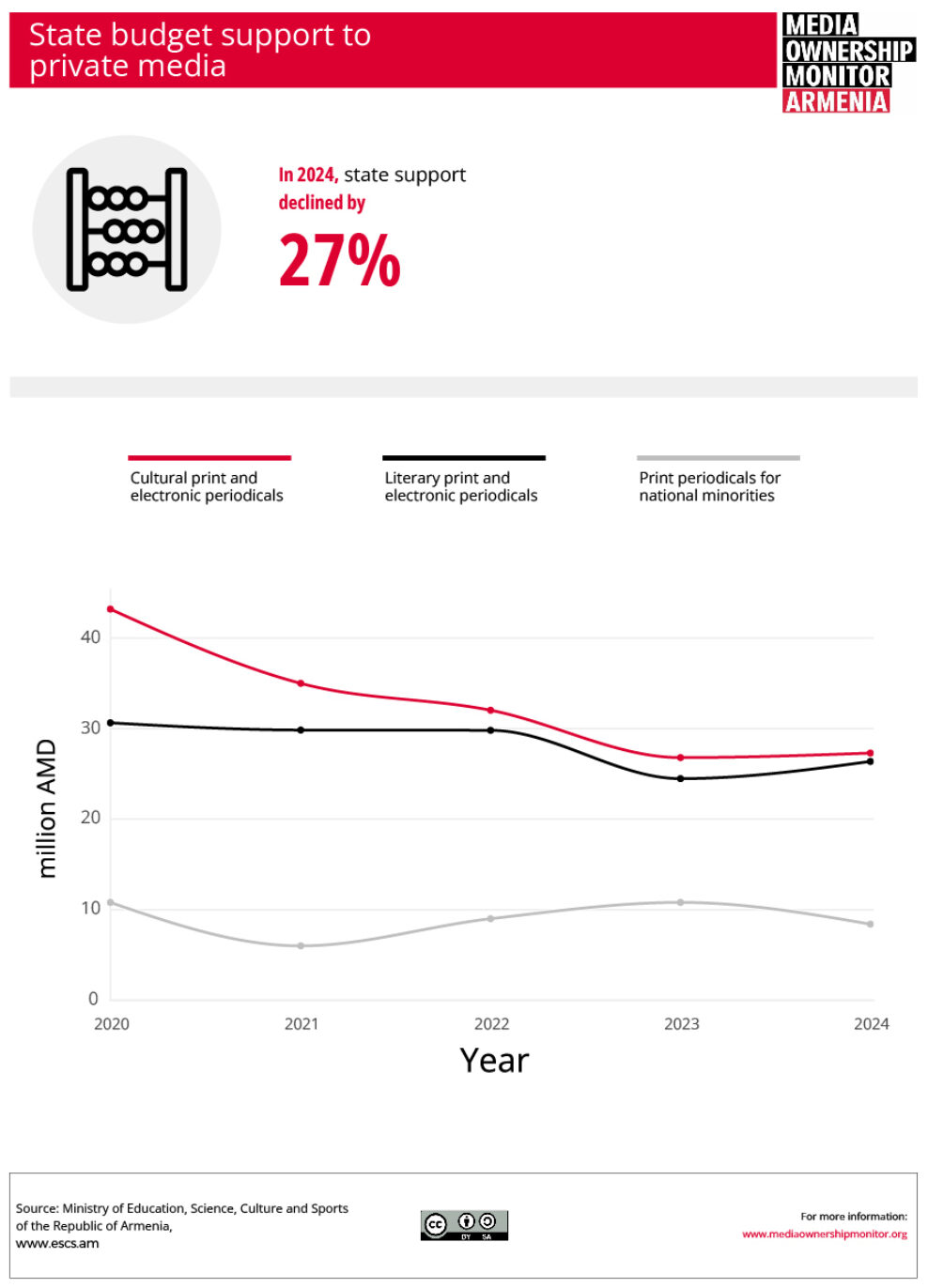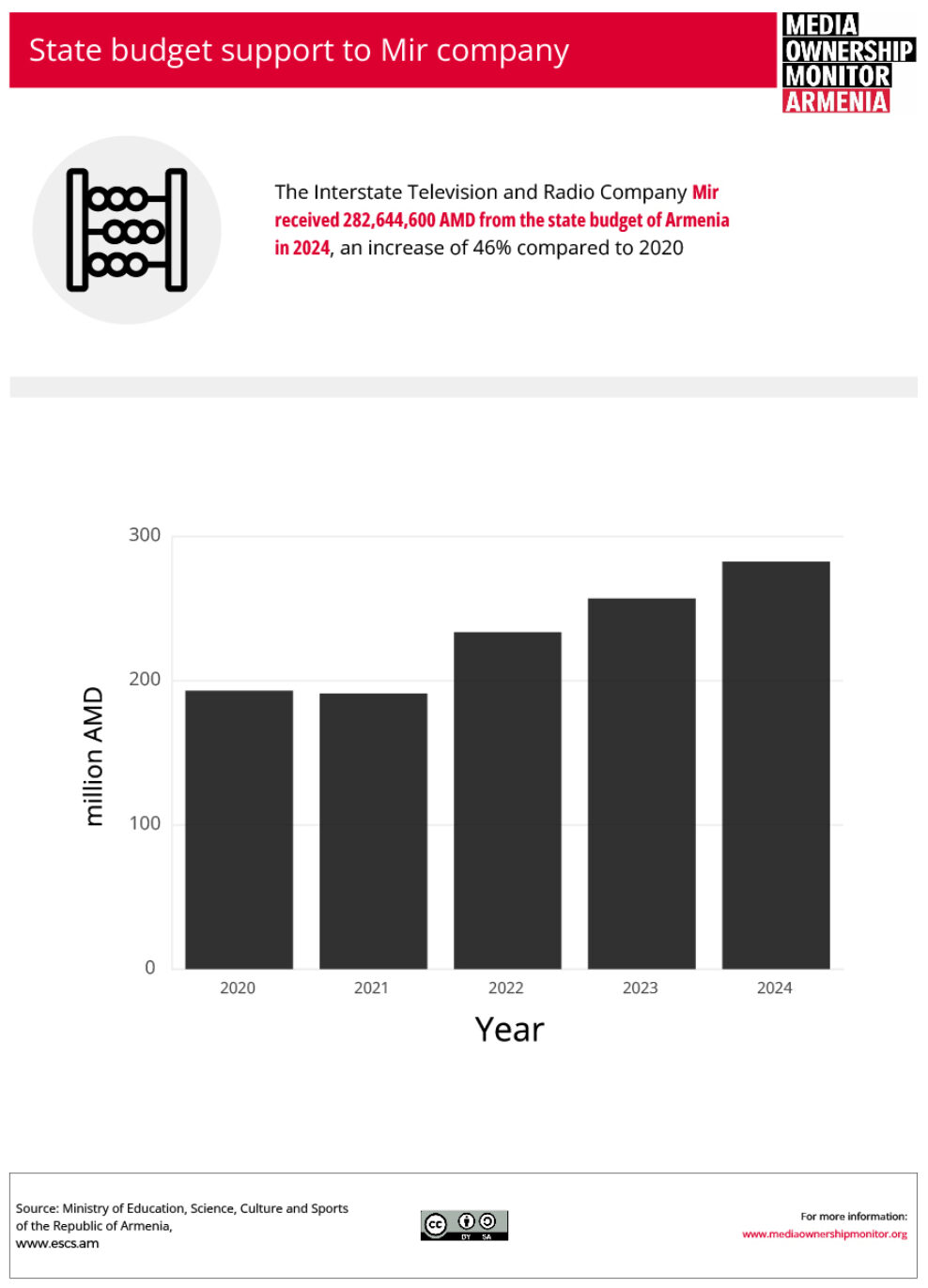State Participation in Media
Armenia's government maintains extensive involvement in the media sector through direct ownership, substantial financial support, and governance oversight. The state directly owns Armenpress news agency and the Public Broadcasting system, while providing significant funding to private media through various programs. The government's 2025 decision to establish a new foundation supporting private broadcasters, amid declining international donor funding, represents both an opportunity for content diversity and a potential risk to media independence. This analysis reveals increasing financial dependency of state media on government funding, concentrated appointment powers within the executive branch, and emerging tensions between public interest objectives and editorial autonomy.
Direct Government Media Ownership
In Armenia, the government directly participates in the media through ownership of closed joint-stock companies, serving as the founder of the state news agency Armenpress (formerly also the newspapers HH and Respublika Armenii) and the Public Broadcasters. These media outlets receive funding from the state budget, creating a direct relationship between government resources and media operations.
State News Agency: Armenpress
Armenpress stands as Armenia's oldest news agency, founded on December 18, 1918, by a decision of the National Assembly of the First Republic of Armenia as the Armenian Telegraph Agency. Operating under various names during the Soviet years, it was renamed Armenpress in 1972 and today functions as a closed joint-stock company whose shares are entirely owned by the Republic of Armenia.
Governance Structure and Control: According to a 2021 government decision, control of Armenpres CJSC rests with the following authorized representatives: the Head of the Prime Minister’s Office (50%), the Prime Minister’s Press Secretary (25%), and the Director of the Public Relations and Information Center SNCO (25%). While the director is elected through competition, the winning candidate must be appointed during meetings of these government-appointed representatives, creating a direct line of executive control over the country’s primary state news outlet.
The current director, Narine Nazaryan, was appointed on March 21, 2022, by decision of the general assembly of authorized representatives. A psychologist by profession, Nazaryan had worked at Armenpress for seventeen years, serving over seven years as deputy director and from 2011 to 2021 as editor-in-chief. Nazaryan is the first woman to lead Armenpress in its more than 100-year history, following the 2021 departure of Aram Ananyan, who headed the agency from 2011 to 2021 before becoming chairman of FlyOne Armenia airline.
Financial Dependency and Operations: operates under direct state budget allocation through the Ministry of Education, Science, Culture and Sports (MESCS), receiving funds under two programs: "Acquisition, preservation, and archiving of information services" and "Provision of official information about Armenia, including on international platforms."The agency's financial data reveals increasing dependence on government funding:

As a state-owned entity, Armenpress's reliance on government funding is inherent to its operational model. However, the data shows declining commercial revenue from 73.8 million AMD to 45 million AMD over five years, suggesting reduced market engagement even as state allocations increased. The concentrated governance structure, where all key appointments flow through the prime minister's representatives, combined with the agency's privileged access to government officials as the official state news source, creates significant competitive advantages over private media outlets in terms of both access to information and financial security.
Market Position and Influence: Armenpress publishes content in ten languages and maintainsa significant digital presence across six social media platforms—Facebook, YouTube, X (Twitter), Instagram, TikTok, and Telegram—with a combined audience of 306,741 followers as of July 30, 2025. The website receives approximately 10,000 daily visitors and 27,000 daily views, with 2.3 million visits and 14 million views recorded between January 1 and July 29, 2025.
Newspapers Consolidation: In 2017, two government newspapers – the daily Hayastani Hanrapetutyun (Republic of Armenia) and the Russian-language Respublika Armenia – were incorporated into Armenpress CJSC. These publications had operated since 1990 and 1992, respectively, serving as official papers for the Supreme Council and later the National Assembly.
These papers were financed from the state budget, but also earned advertising income. Private newspapers had long complained about unfair competition, arguing that state-funded papers could engage in “dumping” by offering lower advertising rates due to their budgetary security, thereby attracting advertisers away from market-dependent outlets. This dynamic illustrates broader tensions in media markets where government-funded outlets compete with private entities facing commercial pressures. However, declining influence led to the government’s June 2023 decision to cease printing both newspapers, citing “low cost-effectiveness,” based on 2022 financial results. The allocated funds were redirected toward modernizing Armenpress, particularly enabling news production in Persian, Georgian, and Chinese.
Public Broadcasting System
Governance and Oversight: According to the “Law on Audiovisual Media,” a Public Broadcaster is defined as a broadcaster owned by a company 100 percent owned by the Republic of Armenia. The Council serves as the body responsible for managing and overseeing the Public Broadcaster, with members selected through competitive processes but appointed by the Prime Minister for six-year terms.
Funding Mechanism: Article 29 of the “Law on Audiovisual Media” defines the financing procedure, requiring the Council to compile and submit annual budgetary funding requests to the Ministry of Finance. These requests are discussed and approved by the National Assembly within the state budget framework, with an important safeguard stipulating that funding cannot fall below the previous year’s budget allocation. This structure provides budget predictability but also entrenches financial dependency on state resources, while the prime minister's direct appointment authority over Council members concentrates oversight control within the executive branch, potentially limiting the broadcaster's autonomy from government influence.
Government Support for Private Media
The Ministry of Education, Science, Culture and Sports (MESCS, since 2008, has implemented a Publication of Non-State Press program operating across three categories: printed periodicals for national minorities in Armenia, literary printed and electronic periodicals (including children’s and youth publications), and cultural printed and electronic periodicals (including children’s and youth publications).
Financial Trends and Distribution: The ministry announces grant competitions, accepts applications, and provides funding based on professional council decisions, with results published on the ministry website. However, funding levels have declined over the five-year period:

The 26.7% reduction in total funding from 2020 to 2024 suggests either budget constraints or shifting government priorities in media support, potentially affecting the viability of cultural and minority-language publications that may lack commercial sustainability.
Interstate Broadcasting Support: Mir Television and Radio Company
The Mir Interstate Television and Radio Company was established on October 9, 1992, with the goal of covering political, economic, and humanitarian cooperation among CIS countries, creating a common information space, and promoting international information exchange. The Republic of Armenia is one of the company's co-founding and shareholder countries.
The company operates on the basis of the international agreement "On International Legal Guarantees for the Unimpeded and Independent Operation of the Mir Interstate Television and Radio Company". The television and radio company comprises the MIR television channel (total audience coverage over 180 million people), MIR 24 television channel (audience over 80 million people), MIR radio (audience over 47.3 million people), and the mir24.tv information platform, and the MIR-Teleport satellite multifunctional system.
On the territory of the Republic of Armenia, Mir content is broadcast on the public multiplex (MIR television channel), through cable operator networks (MIR 24 television channel), and on 93.7 FM frequency (MIR radio).
The state budget provides direct grants to Mir for implementing annual programs of its Armenian national branch. The company has received increasing funding:

The 46.4% increase from 2020 to 2024 contrasts sharply with declining support for domestic non-state media, creating a notable disparity in funding trends that may reflect geopolitical considerations in media investment priorities. This pattern raises questions about the balance between supporting international broadcasting relationships and fostering domestic media diversity.
Diaspora Media Support
The Office of the High Commissioner for Diaspora Affairs operates a separate media support program, providing 56.5 million AMD (143,864,742 USD) in financial assistance over five years — 10 million AMD (25,463 USD) annually from 2020 to 2023, and 16.5 million AMD (42,014 USD) in 2024.
Transparency Concerns: The Commissioner staff declined to specify distribution mechanisms of beneficiary identities, citing information confidentiality and non-disclosure provisions in contracts with beneficiary media outlets. They indicated that support targets Armenian diaspora media outlets and foreign media outlets aimed at “presenting the Armenian agenda abroad and increasing Armenia’s visibility”. This lack of transparency undermines public accountability and makes it difficult to assess whether support serves genuine public interest objectives or reflects political considerations in fund allocation.
The Public Benefit Media Environment Foundation
Establishment and Rationale
On April 17, 2025, the government established the Public Benefit Media Environment foundation to provide grants to broadcasters holding licenses for public multiplex slots, targeting production of public-benefit content, including cultural, educational, training, scientific-educational, children’s, sports, and other audiovisual programs.
Minister of High-Tech Industry Mkhitar Hayrapetyan explained the foundation’s purpose during the Government session: “The goal is to create educational, scientific, cultural, sports, and social content that either cannot generate revenue through commercial means at all, or for which this is very difficult to achieve.” The government’s rationale emphasized protecting citizens from “disinformation, hate speech, external influences, and false agendas”.
Industry Response and Concerns: Although the government has pledged that there will be no attempts to influence editorial policy when providing funds to public multiplex broadcasters, there is still uncertainty regarding the foundation’s overall budget and the specific procedures and conditions that will regulate how these funds are allocated. Journalistic organizations criticized the foundation’s limited scope, stating:
“We value the government’s readiness to promote the wide dissemination of public-benefit content and to provide support for that purpose, especially in the context of the sharp decline in US international assistance. However, considering the changes in audience consumption patterns, the right to benefit from the foundation’s resources should have been granted to all media outlets in Armenia.”
Governance Structure and Leadership
Board Composition: The foundation operates under a seven-member board of trustees making decisions by majority vote, with composition controlled primarily by executive branch appointments:
- Three members nominated by the prime minister
- One each by the Ministries of High-Tech Industry and Education; Science, Culture and Sports
- One by the National Assembly's Standing Committee on Science, Education, Culture, Diaspora, and Youth Affairs
- One by the Television and Radio Commission
- Final board approval by the prime minister
Current Board Members:
- Mkhitar Hayrapetyan – Minister of High-Tech Industry of the Republic of Armenia
- Sisak Gabrielyan – Chair of the National Assembly’s Standing Committee on Science, Education, Culture, Diaspora, Youth, and Sports Affairs
- Tigran Hakobyan – Chair of the Television and Radio Commission
- Daniel Danielyan – Deputy Minister of Education, Science, Culture and Sports of the Republic of Armenia
- Lilya Afrikyan – Head of the Participatory and Open Governance Department, Office of the Prime Minister of Armenia
- Armen Khachatryan – Head of the Information and Public Relations Department, Office of the Prime Minister of Armenia
- Anzhela Kzhdryan – Lecturer, Faculty of Sociology, Yerevan State University
This composition concentrates significant influence within the executive branch, with four of seven members directly connected to the prime minister's office or government ministries. Such centralized control over the foundation's governance may limit its independence in making funding decisions, potentially creating tensions between political priorities and editorial autonomy among beneficiary broadcasters.
Executive Leadership: Vahagn Tevosyan was appointed acting executive director. His background includes serving as an MP in the My Step faction from 2018 to 2021 and as a member of the Public Broadcaster’s Council from 2021 to 2025, demonstrating close connections to both the ruling political party and state media oversight.
Operational Framework and Limitations
Eligibility Restrictions: Participation in grant competitions is limited to television companies holding licenses to broadcast on the public multiplex, effectively restricting access to private television companies only. The Public Television Company cannot participate because it occupies slots by virtue of law rather than license, while foreign TV channels operate under interstate treaty provisions.
This selective eligibility creates a tiered system of access to government support, potentially disadvantaging other media formats and platforms while reinforcing existing broadcast industry structures. Given that the foundation's stated purpose includes protecting citizens from "disinformation, hate speech, external influences, and false agendas"—problems that predominantly manifest online rather than through traditional broadcasting—the exclusion of digital and online media platforms represents a notable gap between the foundation's objectives and its operational scope.
Financial Projections: According to Sisak Gabrielyan, Chair of the National Assembly’s Standing Committee on Science, Education, Culture, Diaspora, Youth and Sports, preliminary information indicates a 500 million AMD (1,273,139 USD) allocation under the 2026 state budget. However, expected international donor contributions were eliminated following U.S. President Donald Trump’s 2025 decision to end foreign media support programs. This development highlights the media sector’s vulnerability to external policy changes and may increase reliance on domestic government funding, potentially intensifying concerns about editorial independence as alternative funding sources diminish.
Current Status: The foundation currently lacks funding and staff, with director selection procedures still under development. Only after competitive director selection and staff formation will the foundation’s final budget be determined and operations commence.
Conclusion: Armenia's government operates as a significant and multifaceted player in the country's media landscape, functioning not only as a regulator but also as a direct owner of major media outlets, a substantial funder of both state and private media, and the primary architect of media support mechanisms. Through its ownership of Armenpress and the Public Broadcasting system, combined with various support programs for private media outlets and the newly established Public Benefit Media Environment foundation, the state maintains extensive involvement across the media ecosystem.
This comprehensive government participation creates both opportunities and challenges. On one hand, state support enables the production of cultural, educational, and minority-language content that may lack commercial viability, ensures information services in multiple languages, and provides stability for public service broadcasting. The competitive selection processes for some leadership positions and transparent grant competitions for certain programs demonstrate attempts to maintain professional standards within government-supported media structures.
The analysis, however, reveals concerning patterns of increasing financial dependency, concentrated appointment powers within the executive branch, and structural arrangements that may compromise editorial independence. Governance structures across Armenia's media institutions consistently channel decision-making authority through the prime minister's office, while financial data shows state media outlets becoming increasingly reliant on government funding rather than developing sustainable commercial operations.
As international donor support declines and domestic government involvement expands through new institutional mechanisms, Armenia's media sector faces critical questions about maintaining the balance between public service objectives and editorial autonomy. The state's dominant role as owner, funder, and oversight authority creates an environment where the line between public service and political influence may become increasingly difficult to maintain, presenting ongoing challenges for media pluralism and democratic discourse.

